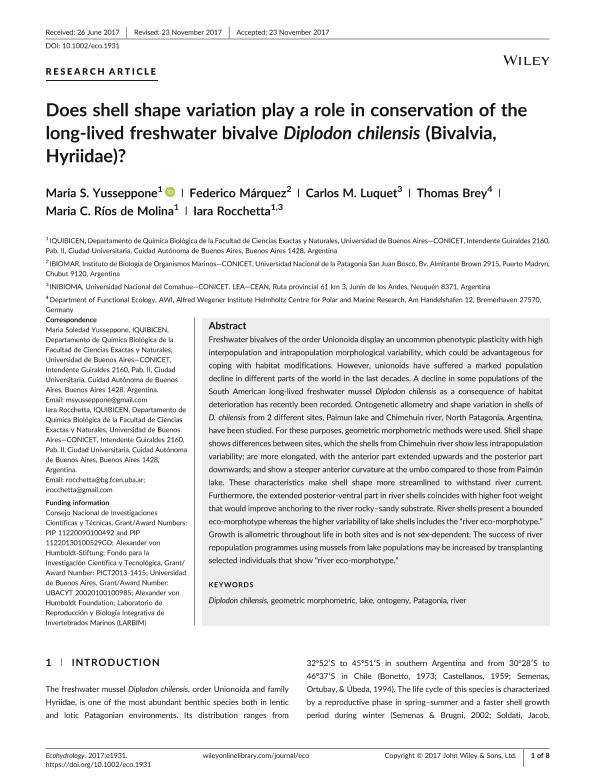Mostrar el registro sencillo del ítem
dc.contributor.author
Yusseppone, Maria Soledad

dc.contributor.author
Marquez, Federico

dc.contributor.author
Luquet, Carlos Marcelo

dc.contributor.author
Brey, Thomas
dc.contributor.author
Ríos de Molina, María C.
dc.contributor.author
Rocchetta, Iara

dc.date.available
2018-02-27T14:46:33Z
dc.date.issued
2017-12
dc.identifier.citation
Yusseppone, Maria Soledad; Marquez, Federico; Luquet, Carlos Marcelo; Brey, Thomas; Ríos de Molina, María C.; et al.; Does Shell shape variation play a role in conservation of the long-lived freshwater bivalve Diplodon chilensis (Bivalvia, Hyriidae)?; John Wiley & Sons Inc; Ecohydrology; 12-2017; 1-8
dc.identifier.issn
1936-0584
dc.identifier.uri
http://hdl.handle.net/11336/37233
dc.description.abstract
Freshwater bivalves of the order Unionoida display an uncommon phenotypic plasticity with high interpopulation and intrapopulation morphological variability, which could be advantageous for coping with habitat modifications. However, unionoids have suffered a marked population decline in different parts of the world in the last decades. A decline in some populations of the South American long-lived freshwater mussel Diplodon chilensis as a consequence of habitat deterioration has recently been recorded. Ontogenetic allometry and shape variation in shells of D. chilensis from 2 different sites, Paimun lake and Chimehuin river, North Patagonia, Argentina, have been studied. For these purposes, geometric morphometric methods were used. Shell shape shows differences between sites, which the shells from Chimehuin river show less intrapopulation variability; are more elongated, with the anterior part extended upwards and the posterior part downwards; and show a steeper anterior curvature at the umbo compared to those from Paimún lake. These characteristics make shell shape more streamlined to withstand river current. Furthermore, the extended posterior-ventral part in river shells coincides with higher foot weight that would improve anchoring to the river rocky–sandy substrate. River shells present a bounded eco-morphotype whereas the higher variability of lake shells includes the “river eco-morphotype.” Growth is allometric throughout life in both sites and is not sex-dependent. The success of river repopulation programmes using mussels from lake populations may be increased by transplanting selected individuals that show “river eco-morphotype.”
dc.format
application/pdf
dc.language.iso
eng
dc.publisher
John Wiley & Sons Inc

dc.rights
info:eu-repo/semantics/openAccess
dc.rights.uri
https://creativecommons.org/licenses/by-nc-sa/2.5/ar/
dc.subject
Diplodon Chilensis
dc.subject
Geometric Morphometric
dc.subject
Ontogeny
dc.subject
Patagonia
dc.subject.classification
Otras Ciencias Biológicas

dc.subject.classification
Ciencias Biológicas

dc.subject.classification
CIENCIAS NATURALES Y EXACTAS

dc.title
Does Shell shape variation play a role in conservation of the long-lived freshwater bivalve Diplodon chilensis (Bivalvia, Hyriidae)?
dc.type
info:eu-repo/semantics/article
dc.type
info:ar-repo/semantics/artículo
dc.type
info:eu-repo/semantics/publishedVersion
dc.date.updated
2018-02-22T14:31:00Z
dc.identifier.eissn
1936-0592
dc.journal.pagination
1-8
dc.journal.pais
Estados Unidos

dc.journal.ciudad
Nueva York
dc.description.fil
Fil: Yusseppone, Maria Soledad. Consejo Nacional de Investigaciones Científicas y Técnicas. Oficina de Coordinación Administrativa Ciudad Universitaria. Instituto de Química Biológica de la Facultad de Ciencias Exactas y Naturales. Universidad de Buenos Aires. Facultad de Ciencias Exactas y Naturales. Instituto de Química Biológica de la Facultad de Ciencias Exactas y Naturales; Argentina
dc.description.fil
Fil: Marquez, Federico. Consejo Nacional de Investigaciones Científicas y Técnicas. Centro Científico Tecnológico Conicet - Centro Nacional Patagónico. Instituto de Biología de Organismos Marinos; Argentina. Universidad Nacional de la Patagonia; Argentina
dc.description.fil
Fil: Luquet, Carlos Marcelo. Consejo Nacional de Investigaciones Científicas y Técnicas. Centro Científico Tecnológico Conicet - Patagonia Norte. Instituto de Investigaciones en Biodiversidad y Medioambiente. Universidad Nacional del Comahue. Centro Regional Universidad Bariloche. Instituto de Investigaciones en Biodiversidad y Medioambiente; Argentina
dc.description.fil
Fil: Brey, Thomas. Alfred Wegener Institute Helmholtz Centre for Polar and Marine Research; Alemania
dc.description.fil
Fil: Ríos de Molina, María C.. Consejo Nacional de Investigaciones Científicas y Técnicas. Oficina de Coordinación Administrativa Ciudad Universitaria. Instituto de Química Biológica de la Facultad de Ciencias Exactas y Naturales. Universidad de Buenos Aires. Facultad de Ciencias Exactas y Naturales. Instituto de Química Biológica de la Facultad de Ciencias Exactas y Naturales; Argentina
dc.description.fil
Fil: Rocchetta, Iara. Consejo Nacional de Investigaciones Científicas y Técnicas. Oficina de Coordinación Administrativa Ciudad Universitaria. Instituto de Química Biológica de la Facultad de Ciencias Exactas y Naturales. Universidad de Buenos Aires. Facultad de Ciencias Exactas y Naturales. Instituto de Química Biológica de la Facultad de Ciencias Exactas y Naturales; Argentina. Consejo Nacional de Investigaciones Científicas y Técnicas. Centro Científico Tecnológico Conicet - Patagonia Norte. Instituto de Investigaciones en Biodiversidad y Medioambiente. Universidad Nacional del Comahue. Centro Regional Universidad Bariloche. Instituto de Investigaciones en Biodiversidad y Medioambiente; Argentina
dc.journal.title
Ecohydrology

dc.relation.alternativeid
info:eu-repo/semantics/altIdentifier/doi/http://dx.doi.org/10.1002/eco.1931
dc.relation.alternativeid
info:eu-repo/semantics/altIdentifier/url/http://onlinelibrary.wiley.com/doi/10.1002/eco.1931/abstract
Archivos asociados
